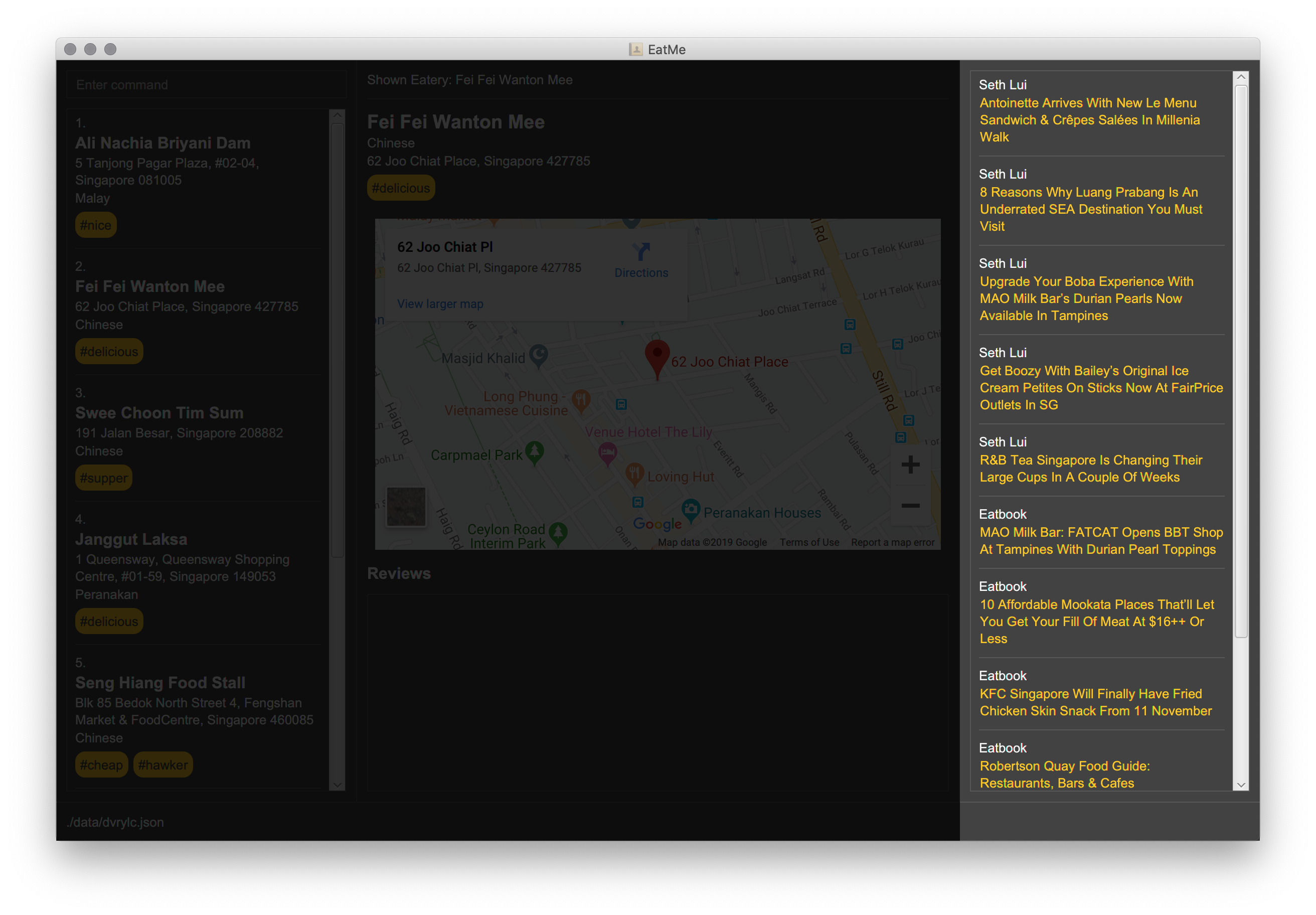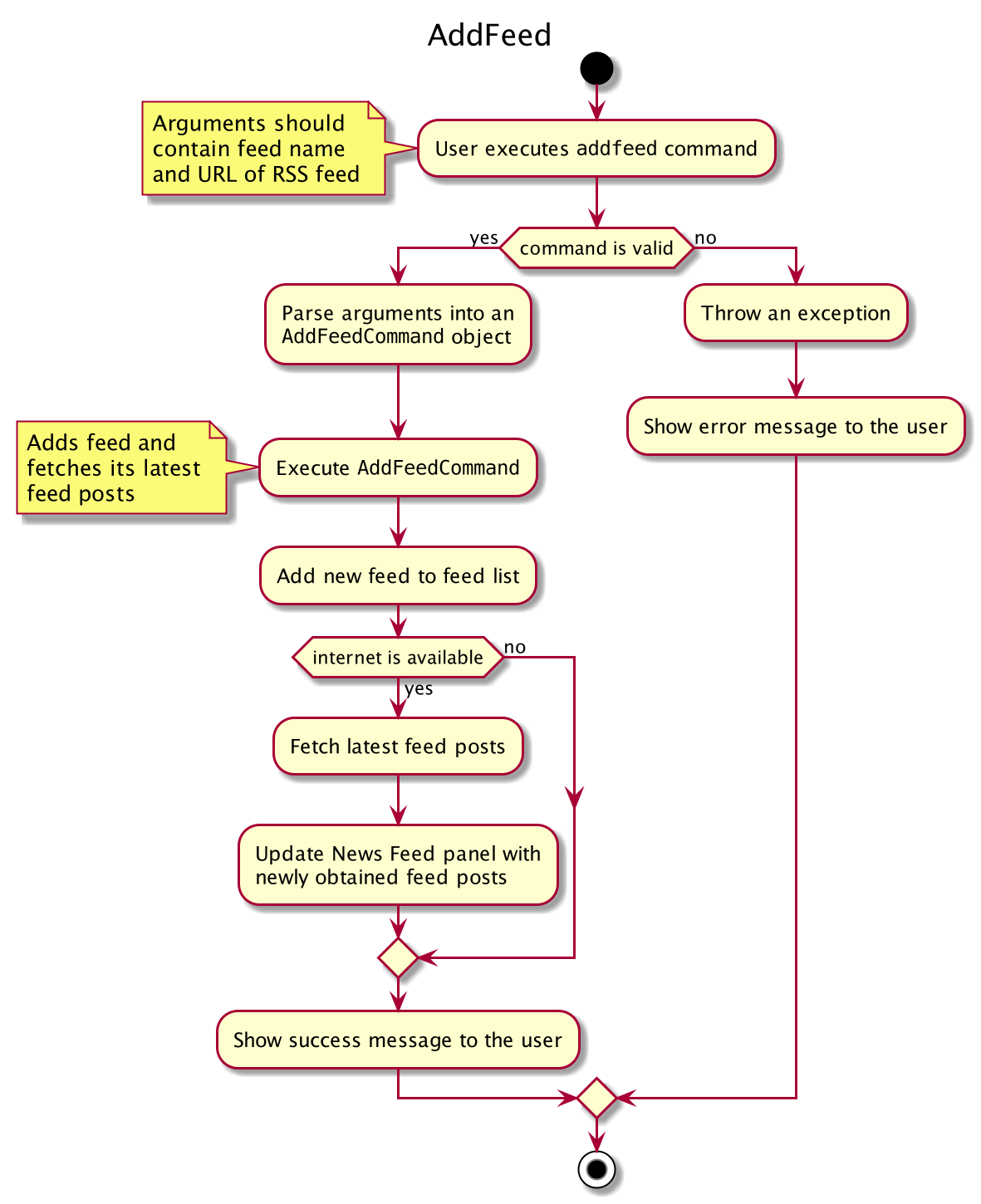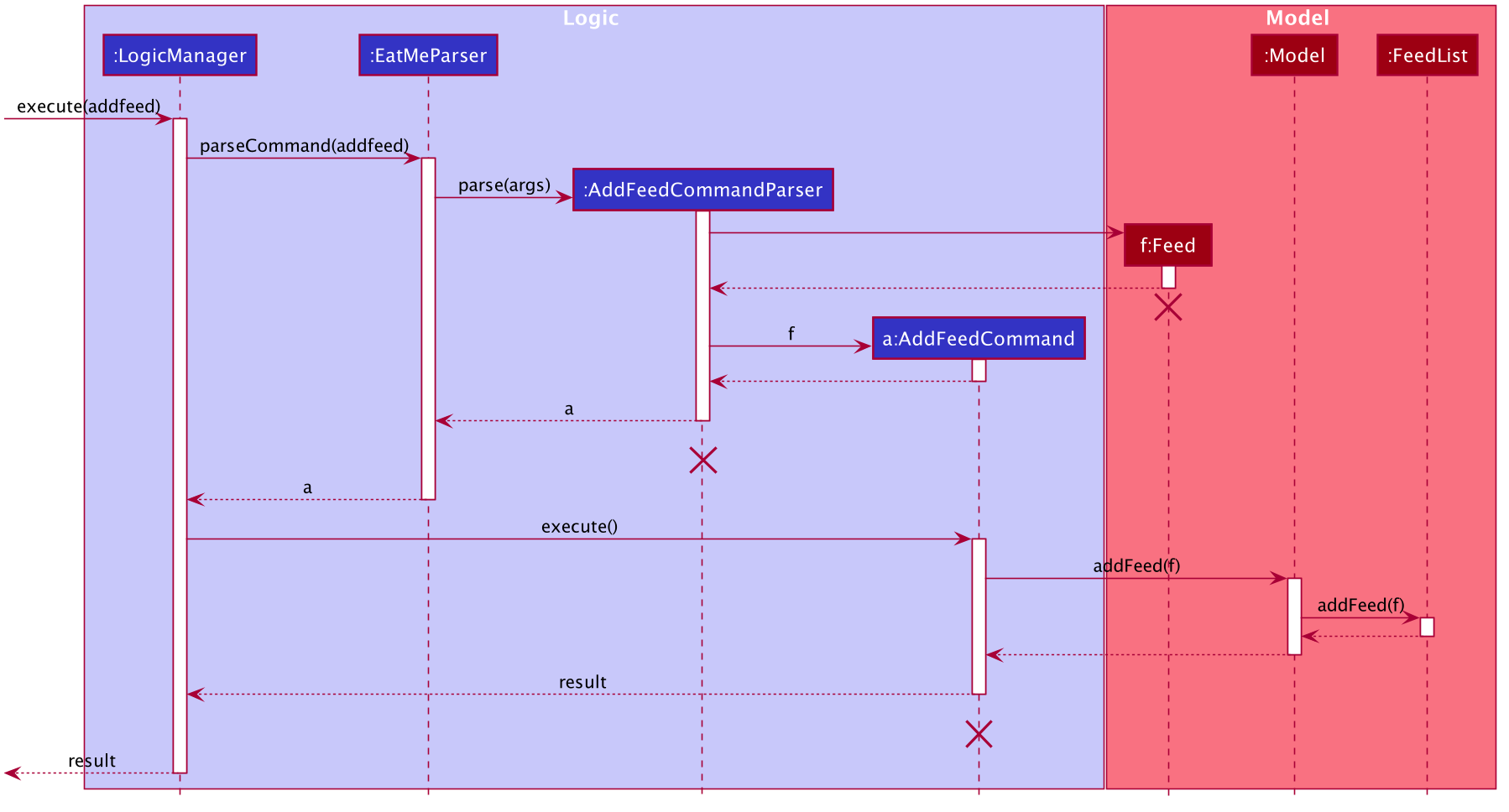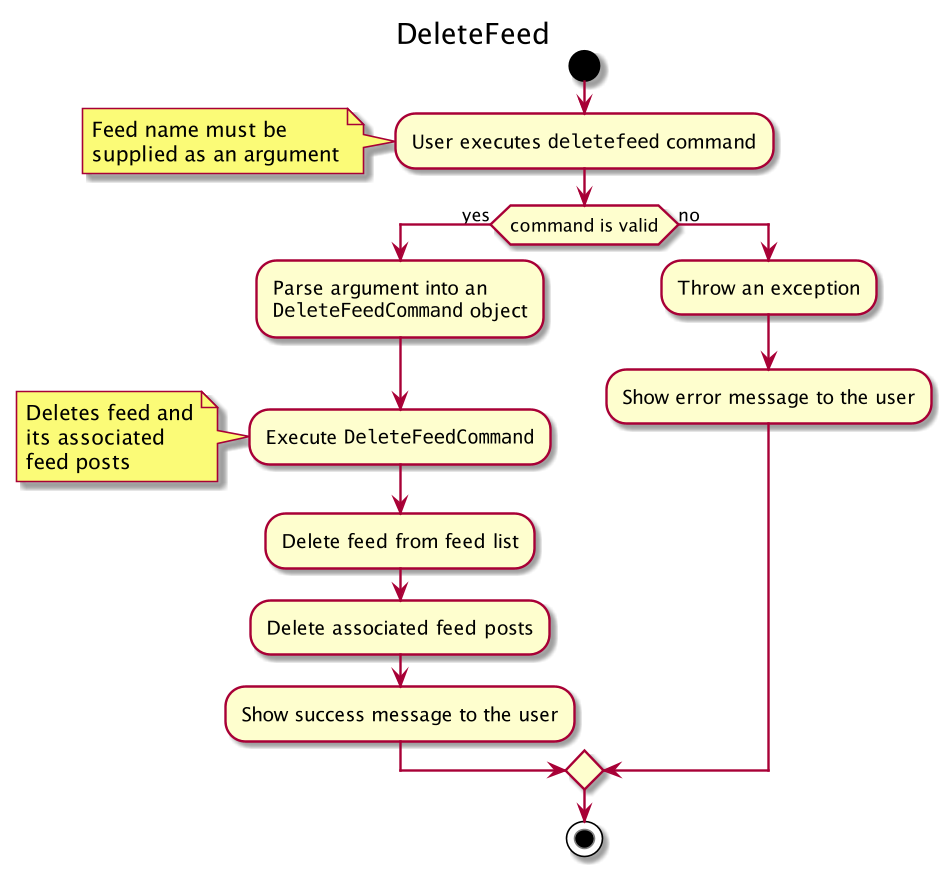Overview
EatMe is a desktop food diary application used for keeping track of favorite places to eat. It also allows the user to easily stay up-to-date with the latest food trends. The user interacts with it using a CLI, and it has a GUI created with JavaFX. It is written in Java, and has about 10kLoC.
Summary of contributions
-
Code contributed: Code contributed
-
Major enhancement: Added the news feed feature

-
What it does: Allows the user to stay up-to-date with the latest food trends using a news feed. The user is able to customize the news feed to their liking by adding or removing their favorite food blogs from the list.
-
Justification: As people who really love food, users are constantly on the lookout for the latest and most interesting kinds of food to try. Users usually stay up-to-date by reading their favorite food blogs. However, if a user has multiple food blogs that they like, going to each blog individually can be time-consuming. As such, we wanted to build a feature that would allow the user to simply add their favorite food blogs to the app and have a list of the latest articles shown to them. To read any of the articles, the user simply has to click on the article to open it up in their browser. This feature would allow our app to be a one-stop solution for all of the user’s food content.
-
Highlights:
-
This feature was challenging to build because it fetches data from the RSS feeds of the user’s favorite food blogs. It involved research on how XML parsing can be done in Java, and a detailed analysis of how the news feed should behave when the user is offline.
-
The implementation was challenging as it required a solution to cache previously fetched articles, so that the user can still view the feed while offline.
-
-
Credits: Besides the JSoup library that was used for XML parsing, all other parts of the feature were self-written.
-
-
Major enhancement: Added the
showcommand
-
What it does: Allows the user to view all the information about an eatery (name, address, category, tags and reviews) and shows the user an interactive map of the eatery’s location for easy navigation.
-
Justification: Since our app allows users to add reviews to an eatery, we needed a way to display the reviews in a simple and visually-pleasing way. Once the user finds an eatery to visit, it is also highly likely that they would need directions to the address. As such, we wanted to provide the user with an interactive map that they can use to navigate to the restaurant.
-
Highlights:
-
The existing AB3 GUI had to be morphed into a 3-column layout to allow for a larger result display that count accomodate the eatery’s information, the reviews and the interactive map.
-
In order for the map to be interactive, an analysis of the available map options also had to be conducted. I evaluated OpenStreetMaps and Google Maps, and decided to use Google Maps because it had a user interface that was more intuitive and familiar to the average user.
-
The implementation was challenging because we had to use JavaFX’s WebView and an embedded Google Map. This involved working with the Google Maps API and making API calls that are signed with a Google Maps API Key.
-
-
-
Minor enhancement: Add visual indicator for closed eateries
-
What it does: Highlights closed eateries in red.
-
Justification: When the user marks an eatery as "closed", it means that the eatery has closed down and is no longer operational. It is important that there is a visual indicator for the user to tell that the eatery is closed, so that the user doesn’t try to visit it.
-
Relevant PRs: #164
-
-
Other contributions:
-
Project management:
-
Managed releases
v1.1-v1.4(4 releases) on GitHub
-
-
Enhancements to existing features:
-
Documentation:
-
Community:
-
Tools:
-
Integrated a third party library (JSoup) to the project (PR #73)
-
-
Contributions to the User Guide
Given below are sections I contributed to the User Guide. They showcase my ability to write documentation targeting end-users. |
News Feed
EatMe allows you to stay up-to-date with the latest food trends from right within the app! Add your favorite food blogs into the app and EatMe will show you a list of the latest articles from those blogs on the right panel. To view any of the articles, simply click on the title of the post.
Terminology:
-
feed- A food blog -
feed post- A single post from a food blog
Adding a feed : addfeed
Adds a new feed to the app.
Format: addfeed \n [name of feed] \a [Web address of the feed]
Example:
-
addfeed \n Eatbook \a https://eatbook.com/feed
Deleting a feed : deletefeed
Deletes a feed from the app.
Format: deletefeed \n [name of feed]
Examples:
-
deletefeed \n Eatbook
Viewing an eatery: show
Shows an eatery with all its details - address, tags, reviews, and a map of its location.
Format: show [index]
Examples:
-
show 2
Contributions to the Developer Guide
Given below are sections I contributed to the Developer Guide. They showcase my ability to write technical documentation and the technical depth of my contributions to the project. |
News Feed Feature
As people who really love food, we are interested in keeping up-to-date with the latest food trends and newest eateries to try. The news feed allows the user to save their favorite food blogs to EatMe and have access to the latest food-related articles right from within the app. Should a food blog become irrelevant, the user also has the option to remove it and no longer display its articles.
Terminology
Some terms are used in this feature:
-
Feed- A food blog -
Feed Post- An article from a feed -
News Feed Panel- The right column of the app showing news articles
Implementation
The current news feed supports two commands:
-
AddFeed- Add a new feed -
DeleteFeed- Delete a feed and its associated feed posts
AddFeed - Add a new feed
The following activity diagram shows the flow when the user wants to add a new feed.

Step 1. The user launches the application.
Step 2. EatMe fetches the latest feed posts from the user’s existing feeds and displays them to the user in the news feed panel.
Step 3. The user finds a new favorite food blog called Eatbook and wants to add it into the app. The user executes addfeed \n Eatbook \a https://eatbook.sg/feed to add the new feed. AddFeedCommand calls Model#addFeed with the new feed object, which will in turn add the new feed to the Model’s internal feed list.
The following sequence diagram shows how the AddFeed command executes.

DeleteFeed - Delete a feed and its associated feed posts
The following activity diagram shows the flow when the user wants to delete a feed.

Step 1. The user launches the application.
Step 2. EatMe fetches the latest feed posts from the user’s existing feeds and displays them to the user in the news feed panel.
Step 3. The user is no longer interested in the food blog Eatbook and wants to delete it from the app. The user executes deletefeed \n Eatbook to delete the feed. DeleteFeedCommand calls Model#deleteFeed with the feed to delete, which will in turn remove the feed to the Model’s internal feed list.
The following sequence diagram shows how the DeleteFeed command executes.

Design Considerations
Aspect: Storage of feed list
-
Alternative 1: Store the feed list in the existing Eatery list JSON file.
-
Pros: Single JSON file for all of the user’s data (eateries, todos, feeds).
-
Cons: When sharing your JSON file with another user, the feeds would be transferred as well - Poor user experience because favorite food blogs are a personal choice and should not be transferred when sharing eateries.
-
-
Alternative 2 (current choice): Store the feed list as a separate JSON file.
-
Pros: Separation of eatery-related and feed-related information into two separate JSON files - Allows sharing of eateries without affecting feeds.
-
Cons: Two separate files - Minor inconvenience if the user wants to backup their data to another location.
-
Aspect: Offline behavior of news feed
-
Alternative 1 (current implementation): Store the feed posts from the last successful update in the feed list JSON file
-
Pros: Allows for offline access to feed posts.
-
Cons:
-
Feed posts may be outdated if the user has not opened the app with Internet connectivity for a long time.
-
Larger feed list JSON file size.
-
-
-
Alternative 2: Show an error message when offline.
-
Pros: Small and simple feed list JSON file.
-
Cons: Unable to view feed posts when offline.
-